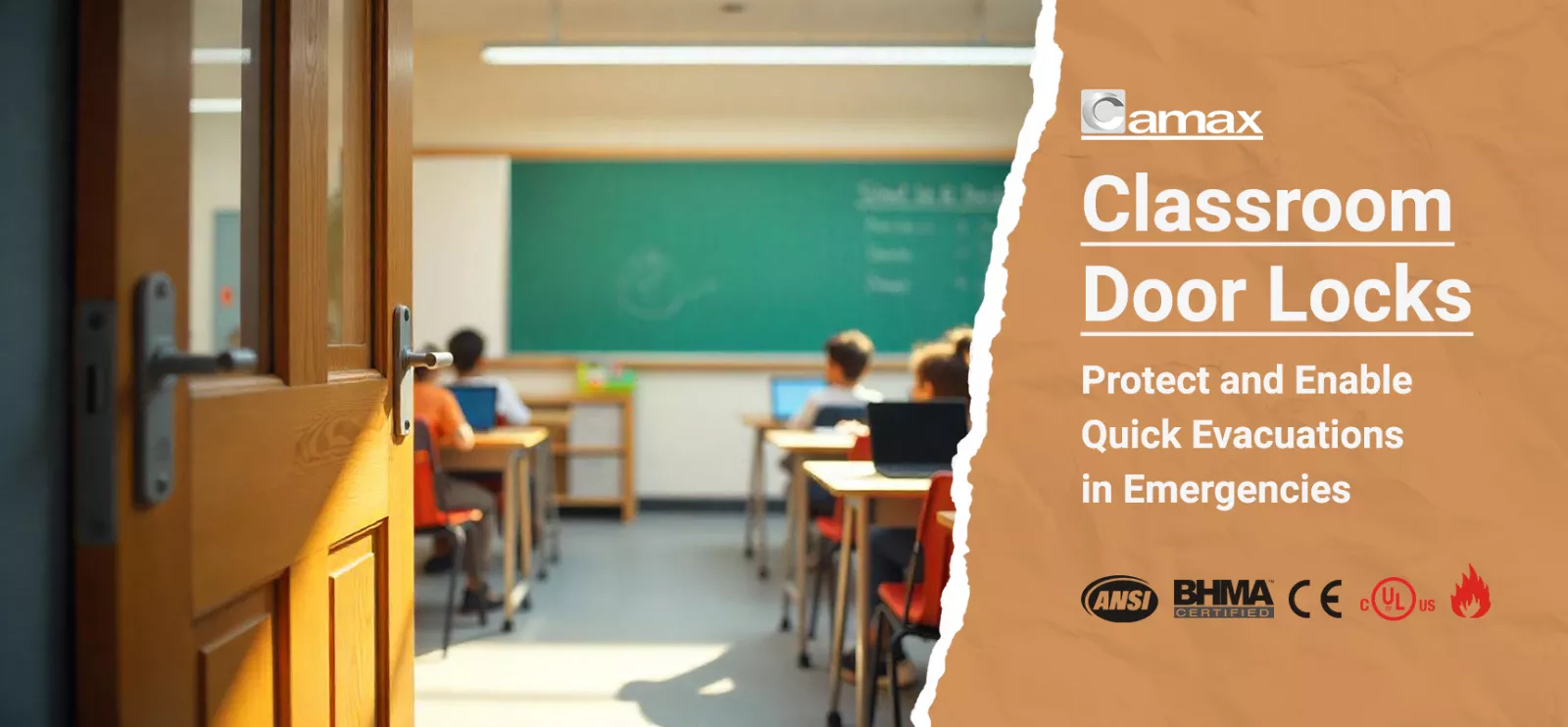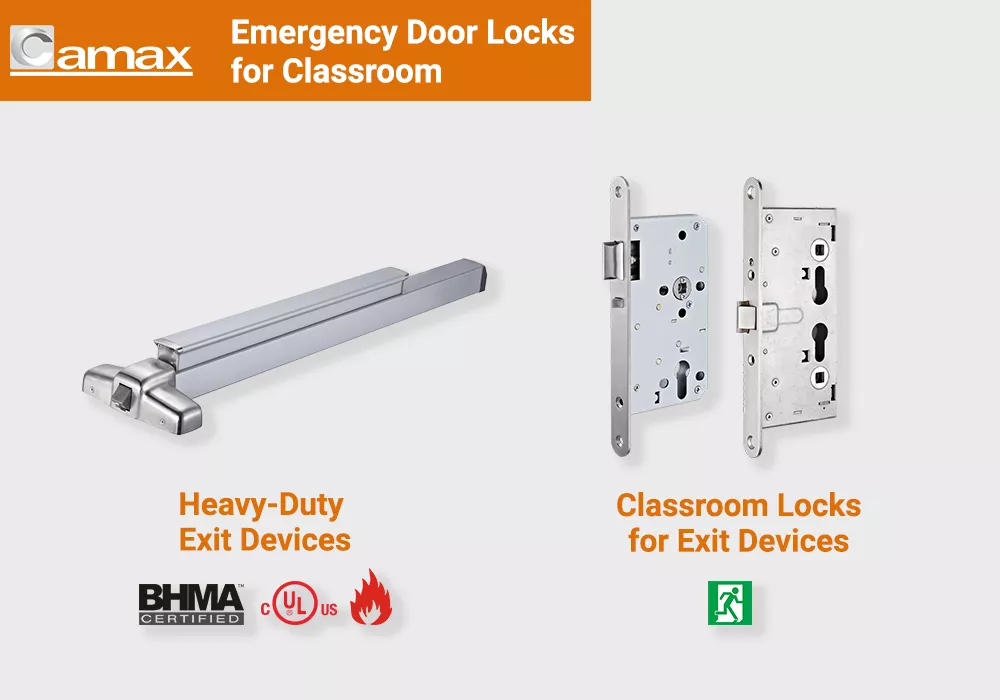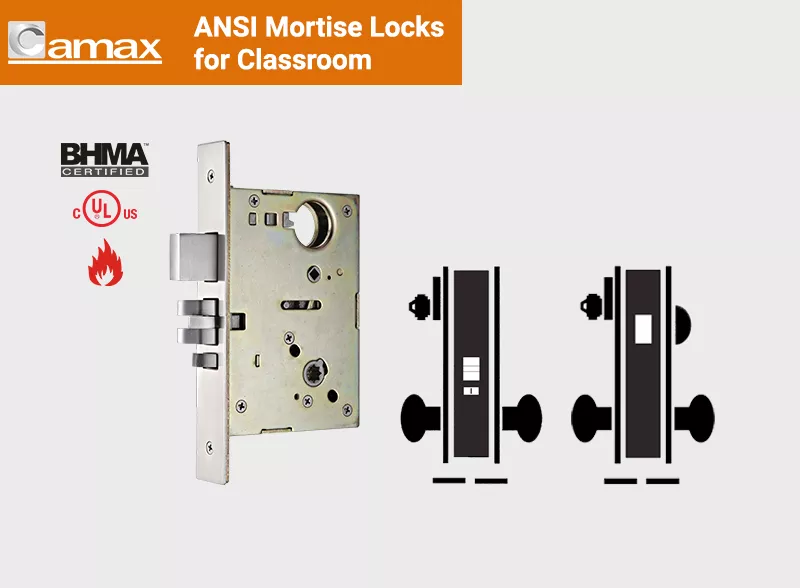
In any educational setting, the safety of students and staff is paramount. Schools are not just places of learning but also sanctuaries where children should feel secure. However, emergencies such as fires, natural disasters, or security threats can disrupt this sense of safety, making it crucial to have robust safety measures in place. One such critical component is the emergency door lock system.
Classroom locks play a pivotal role during evacuations by ensuring doors can be secured or opened as needed. While their primary function is to protect against intrusions, they must also facilitate swift and safe exits in emergencies. Balancing security and accessibility is no easy task, but it is essential for creating a safe learning environment.
This article explores how classroom door locks contribute to classroom safety and evacuation efficiency, highlighting their key features and the importance of proper training for their use.
Table of contents
The Role of Classroom Locks in Classroom Safety
Classroom locks play a crucial role in ensuring the safety of classrooms by serving dual purposes. Their primary function is to secure the space during critical incidents, such as intrusions or lockdown situations, providing an essential line of defense against potential threats. By creating a reliable and robust barrier against unauthorized entry, these classroom door locks not only help to prevent access by intruders but also foster a sense of security within the classroom.
Their secondary function, however, is equally critical—facilitating controlled and efficient evacuations in times of crisis. In emergencies such as fires, earthquakes, or other natural disasters, every second can mean the difference between safety and harm. The emergency door locks for classroom designed with quick-release mechanisms play a pivotal role in these situations, allowing doors to be unlocked and opened swiftly. This capability is essential in preventing delays that could otherwise escalate panic and confusion among students and staff.
For instance, during a fire drill, classroom locks with efficient emergency function allow students to exit swiftly while preventing the doors from jamming or malfunctioning. Similarly, in an active shooter scenario, locks can secure the room and prevent entry while maintaining the option for rapid evacuation if the threat moves away.
Features of Classroom Locks for Evacuations
Not all classroom locks are designed equally when it comes to handling emergency situations. Certain features are essential for ensuring their effectiveness during evacuations. Below are some of the most critical characteristics.
Quick-Release Mechanisms
In emergencies, doors must be unlocked within seconds. Quick-release mechanisms, such as push bars or turn knobs, provide this functionality. For example, push bars paired with classroom locks for exit devices are a popular choice in commercial and institutional settings due to their simplicity and effectiveness, making them equally ideal for classrooms. These devices are designed with user safety and efficiency in mind, allowing individuals to unlock and open a door in one seamless motion by simply pushing the bar. This intuitive mechanism is especially useful in emergencies, as it minimizes delays and reduces the need for fine motor skills or additional tools, which can be challenging in high-stress situations.
Push bars are also highly reliable, as they function smoothly even under pressure, such as during fires or crowded evacuations. Their ergonomic design ensures that students, teachers, and even young children can operate them without difficulty. By facilitating quick and unobstructed exits, push bars paired with classroom locks provide a practical and essential solution for emergency preparedness in educational environments.

Keyless systems, like electronic locks, are another option. These systems enable teachers to unlock doors using codes or fobs, offering both speed and ease of use.
Dual-Functionality Locks
A good emergency lock for classroom must be versatile and adaptable to handle the wide range of scenarios that may occur in a classroom setting. Emergencies can vary greatly, from lockdown situations requiring immediate security to evacuation scenarios necessitating a quick and unobstructed exit. Dual-functionality locks are designed to address these diverse needs, offering the flexibility to secure a room effectively during a lockdown while also allowing for fast evacuation when the situation calls for it.
For example, advanced smart locks equipped with remote control or override features empower school administrators or security personnel to manage access dynamically. In a lockdown, these locks can be activated to create a secure barrier against intruders. Conversely, during a fire or another emergency requiring evacuation, the same locks can be overridden or unlocked remotely to facilitate a safe and swift exit.
Compliance with Safety Codes
Compliance with fire safety standards and local regulations is non-negotiable. Emergency door locks for classroom must meet standards like those set by ANSI (American National Standards Institute) to ensure safety and reliability. ANSI commercial locks, such as Camax’s CML800 Series, stand out as excellent examples of emergency door locks that prioritize both safety and functionality. These locks are meticulously engineered to meet and exceed stringent safety codes and standards, ensuring their reliability in critical situations. Their design reflects a deep understanding of the challenges posed by emergencies, making them a trusted choice for schools, commercial buildings, and other high-traffic environments.

One of their most significant advantages is their panic-proof functionality. This feature is essential in ensuring that individuals can quickly and easily exit a room during emergencies without becoming trapped due to complex or malfunctioning lock mechanisms. Whether it's a fire, a natural disaster, or another urgent situation, the classroom locks of CML800 Series are designed to facilitate a smooth and swift exit while maintaining the structural integrity required to withstand force or tampering.
Durability and Reliability
Classroom emergency door locks must perform under extreme conditions, such as high heat during fires or the presence of debris after an earthquake. Durable materials and anti-tampering designs ensure locks remain functional when needed most. Wear-resistant features also extend the lifespan of the locks, reducing maintenance costs over time.
Camax’s mortise locks, including those designed for classrooms, undergo rigorous testing to ensure their performance, durability, and reliability in various conditions. These locks are subject to a series of comprehensive evaluations, which simulate a wide range of potential challenges they may face in real-world scenarios, from extreme weather conditions to heavy usage. Each lock is tested for its ability to resist tampering, wear, and damage, ensuring that it continues to function as expected when needed most—whether during an emergency or day-to-day use.
By passing these numerous tests, Camax’s mortise locks are proven to be highly effective in classroom settings, providing peace of mind to both teachers and students. Their robust construction and superior performance make them a dependable choice for institutions looking to enhance safety while ensuring that doors function smoothly and securely under various conditions.

Training for Effective Use of Emergency Door Locks
Even the best emergency door locks are ineffective without proper training. Educating staff and students on their operation is essential for ensuring swift and safe evacuations.
Importance of Education
Teachers and students must understand how to use emergency door locks, whether it involves pressing a push bar or entering a code. Misunderstandings or confusion during an emergency can lead to delays and potential harm.
Regular Drills and Simulations
Practice makes perfect. Regular drills and simulations help familiarize everyone with lock mechanisms, making the response second nature during real emergencies. These exercises should cover various scenarios, such as fires, lockdowns, and natural disasters, to ensure comprehensive preparedness.
When and How to Override Locks
In some emergencies, locks may need to be overridden, such as when a door becomes jammed. Training should include instructions on when and how to use override features, ensuring that everyone knows what to do if the primary mechanism fails.
Role of School Administrators
School administrators play a crucial role in ensuring the success of training programs. They must schedule regular drills, provide resources for lock maintenance, and ensure staff and students are well-informed about emergency procedures. Administrators should also evaluate the effectiveness of training and adjust strategies as needed.
Choose the Right Classroom Door Locks for Safety During Emergencies
Emergency door locks are a vital component of classroom safety, offering both security and evacuation efficiency. Their dual functionality, compliance with safety standards, and durability make them indispensable in educational settings. However, even the most advanced locks require proper training to maximize their effectiveness.
If you’re looking for a high-quality solution, Camax’s classroom locks are an excellent choice. These classroom locks are designed with the highest safety standards in mind, offering peace of mind with their strong security features and quick-release mechanisms. The CML800 Series is built to be reliable, easy to use, and fully compliant with emergency safety regulations, making them a smart investment for schools.
Contact Camax today for more information about our classroom locks and emergency door lock solutions.
Need help? Contact Camax for a quote!
Discover Camax's door & window hardware with ANSI/BHMA/UL/CE certification today!

